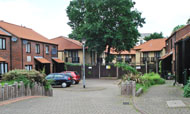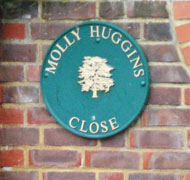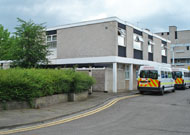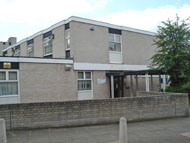Weir Maternity Hospital
12 Weir Road, Balham, SW12 0LZ
Medical dates:
Medical character:
General. Later, maternity
Founded
under the provision of the Will of the late Benjamin Weir, who had died
in February 1902, the Weir Hospital opened in Grove Road, Balham, in
December 1911. Because of certain restrictive covenants and the
controversy as to the manner in which the provisions of the Will should
be carried into effect, it had taken this length of time to establish
the Hospital. (During this long interim period a dispensary had
been opened at 22 Old Devonshire Road, a property also part of the Weir
request.)
Part of the Hospital site had previously been occupied by 'The Hawthorns', the home of the late benefactor. An adjoining property had been purchased with Weir Trust monies.
When war broke out in 1914 the Kensington Division of the Red Cross Society searched in its Borough for a suitable property in which to establish a hospital, but was unable to find one. However, the Trustees of the Weir Hospital offered the Division its hospital buildings free of rent. (In fact, the Division's centre of activities during the war remained outside the Royal Borough.)
On 17th November 1914, during WW1, the Hospital was taken over by the Kensington Division of the British Red Cross Society. It became the Kensington Red Cross War Hospital, a section of the Third London (T.F.) General Hospital. It was one of the most up-to-date hospitals with every facility. It had an excellent operating theatre and, thanks to Mrs Whitaker Thompson and another anonymous donor, a modern X-ray apparatus.
Initially, the Hospital was staffed by 4 trained nurses and 23 full-time members of a Voluntary Aid Detachment. Initially it received patients from the Third London General Hospital, but soon wounded servicemen were received directly from the Front, from the theatres of war in France and Mesopotamia. (It was one of four London hospitals which received patients directly from abroad instead of via a military hospital. The other three were the Gerstley-Hoare Hospital for Officers, and the Hospitals for Officers at 24 Park Street and 27 Berkeley Square.)
Initially, it had 36 beds but this soon proved inadequate and a house was obtained rent-free for staff quarters, releasing space for more beds. By the end of December 1914 the Hospital's 50 beds were occupied.
In the autumn of 1915 another ward was made available, so that after ten months of opening, the War Hospital had 100 beds.
During the autumn a special fund had also been raised to provide a hospital chapel. The hutted building opened on 26th November 1915, the first anniversary of the War Hospital, and was dedicated to St Michael and All Angels. The Bishop of Kensington and the Vicar of Kensington officiated.
Between December 1915 and February 1916, some £2,300 was raised to defray running expenses.
In April 1916 a new ward with 60 beds was opened by Princess Louise, the Duchess of Argyll. The Bishop of Kensington blessed the ward.
The Hospital eventually had 160 beds, mostly in hutted wards. It was staffed by 10 trained nurses, as well as 50 full-time and 5 part-time members of the Voluntary Aid Detachment, who did all the cooking, housework and much of the nursing.
It closed as a military hospital on 30th June 1919, by which time 4,535 wounded men had been treated, many of them serious cases. Only five had died.
In 1920 it became a general hospital again, with 30 beds and an Out-Patients Department.
In 1931 Wandsworth Borough Council built a new maternity hospital - the Wandsworth War Memorial Maternity Home - on a site adjacent to the Weir Hospital, to replace its original one at Park Hill. It had 20 beds, plus 2 beds in an isolation ward. The Weir Hospital administered the Home until the Council took over in 1934.
In 1936 Grove Road was renamed Weir Road.
In 1948 the Hospital joined the NHS. The Regional Board considered that it was uneconomical to run a small 30-bedded hospital as a general hospital for all specialties and that it should become a specialised unit. It was decided to combine the Weir with the Wandsworth War Memorial Maternity Home as both properties were adjoining.
The closing of the Weir Hospital as a general hospital, with its high standard of service, caused dismay to the local population, but the Hospital Management Committee had no hesitation in accepting the decision of the Regional Board (the administrative offices for the Wandsworth Hospital Group were housed on the ground floor of the Hospital).
The Weir Hospital closed as a general hospital on 31st May 1950 and, following alterations and redecoration, re-opened a few weeks later on 21st August. Combined with the Wandsworth War Memorial Maternity Home, now both known as the Weir Maternity Hospital, the new unit had 50 beds.
In 1951 a premature baby unit was opened in a separate wing, with 12 cots; the unit at St James' Hospital was closed. By this time the Weir Hospital had 63 beds. In the same year the Hospital was completely rewired and a fire alarm system installed. The Weir Trust Fund paid for new carpets and bedspreads for the resident nursing staff. Some accommodation at the rear of the Hospital was adapted for a new Chest Clinic to replace the one situated at 91 Bedford Hill, where the premises had been shared with the LCC Child Welfare Clinic - an unsatisfactory arrangement.
During 1965 and 1966 a new maternity unit was built, at the cost of £42,000.
The Hospital closed in 1977, when government health policy dictated that maternity units should be located within district general hospitals.
Part of the Hospital site had previously been occupied by 'The Hawthorns', the home of the late benefactor. An adjoining property had been purchased with Weir Trust monies.
When war broke out in 1914 the Kensington Division of the Red Cross Society searched in its Borough for a suitable property in which to establish a hospital, but was unable to find one. However, the Trustees of the Weir Hospital offered the Division its hospital buildings free of rent. (In fact, the Division's centre of activities during the war remained outside the Royal Borough.)
On 17th November 1914, during WW1, the Hospital was taken over by the Kensington Division of the British Red Cross Society. It became the Kensington Red Cross War Hospital, a section of the Third London (T.F.) General Hospital. It was one of the most up-to-date hospitals with every facility. It had an excellent operating theatre and, thanks to Mrs Whitaker Thompson and another anonymous donor, a modern X-ray apparatus.
Initially, the Hospital was staffed by 4 trained nurses and 23 full-time members of a Voluntary Aid Detachment. Initially it received patients from the Third London General Hospital, but soon wounded servicemen were received directly from the Front, from the theatres of war in France and Mesopotamia. (It was one of four London hospitals which received patients directly from abroad instead of via a military hospital. The other three were the Gerstley-Hoare Hospital for Officers, and the Hospitals for Officers at 24 Park Street and 27 Berkeley Square.)
Initially, it had 36 beds but this soon proved inadequate and a house was obtained rent-free for staff quarters, releasing space for more beds. By the end of December 1914 the Hospital's 50 beds were occupied.
In the autumn of 1915 another ward was made available, so that after ten months of opening, the War Hospital had 100 beds.
During the autumn a special fund had also been raised to provide a hospital chapel. The hutted building opened on 26th November 1915, the first anniversary of the War Hospital, and was dedicated to St Michael and All Angels. The Bishop of Kensington and the Vicar of Kensington officiated.
Between December 1915 and February 1916, some £2,300 was raised to defray running expenses.
In April 1916 a new ward with 60 beds was opened by Princess Louise, the Duchess of Argyll. The Bishop of Kensington blessed the ward.
The Hospital eventually had 160 beds, mostly in hutted wards. It was staffed by 10 trained nurses, as well as 50 full-time and 5 part-time members of the Voluntary Aid Detachment, who did all the cooking, housework and much of the nursing.
It closed as a military hospital on 30th June 1919, by which time 4,535 wounded men had been treated, many of them serious cases. Only five had died.
In 1920 it became a general hospital again, with 30 beds and an Out-Patients Department.
In 1931 Wandsworth Borough Council built a new maternity hospital - the Wandsworth War Memorial Maternity Home - on a site adjacent to the Weir Hospital, to replace its original one at Park Hill. It had 20 beds, plus 2 beds in an isolation ward. The Weir Hospital administered the Home until the Council took over in 1934.
In 1936 Grove Road was renamed Weir Road.
In 1948 the Hospital joined the NHS. The Regional Board considered that it was uneconomical to run a small 30-bedded hospital as a general hospital for all specialties and that it should become a specialised unit. It was decided to combine the Weir with the Wandsworth War Memorial Maternity Home as both properties were adjoining.
The closing of the Weir Hospital as a general hospital, with its high standard of service, caused dismay to the local population, but the Hospital Management Committee had no hesitation in accepting the decision of the Regional Board (the administrative offices for the Wandsworth Hospital Group were housed on the ground floor of the Hospital).
The Weir Hospital closed as a general hospital on 31st May 1950 and, following alterations and redecoration, re-opened a few weeks later on 21st August. Combined with the Wandsworth War Memorial Maternity Home, now both known as the Weir Maternity Hospital, the new unit had 50 beds.
In 1951 a premature baby unit was opened in a separate wing, with 12 cots; the unit at St James' Hospital was closed. By this time the Weir Hospital had 63 beds. In the same year the Hospital was completely rewired and a fire alarm system installed. The Weir Trust Fund paid for new carpets and bedspreads for the resident nursing staff. Some accommodation at the rear of the Hospital was adapted for a new Chest Clinic to replace the one situated at 91 Bedford Hill, where the premises had been shared with the LCC Child Welfare Clinic - an unsatisfactory arrangement.
During 1965 and 1966 a new maternity unit was built, at the cost of £42,000.
The Hospital closed in 1977, when government health policy dictated that maternity units should be located within district general hospitals.
Present status (June 2008)
Apart from the 1931 Wandsworth maternity home building, the
Hospital has been demolished. The site was redeveloped by the
Metropolitan Housing Trust in 1987 and it is now a housing estate -
Molly Huggins Close.

The only part of the Hospital to survive is the 1931 block.
The central portion of the building bears the date '1931' and the Hospital crest with the motto 'We serve' in stonework.





The Metropolitan Housing Trust named the new development after its founder, Lady Molly Huggins.


In Belthorn Crescent, off Weir Road, is the Eamonn Fortell Centre (previously STAR Services Day Hospital), a mental health care facility operated by the South London and Maudsley NHS Trust (SLAM).
(Author unstated) 1914 Summary of work since outbreak of war to date. London, British Red Cross Society.
(Author unstated) 1917 List of the various hospitals treating military cases in the United Kingdom. London, H.M.S.O.
(Author unstated) 1925 The British Red Cross Society. County of London Branch Annual Reports 1914-1924. London, Harrison & Sons.
Campbell C 1977 Closing the Weir. Midwives Chronicle 90 (1077), 244.
Reid H 1949 British Red Cross Society. Story of the County of London Branch. London, British Red Cross Society.
http://landmark.lambeth.gov.uk (1)
http://landmark.lambeth.gov.uk (2)
www.geograph.org.uk
www.lambeth.gov.uk
Return to home page